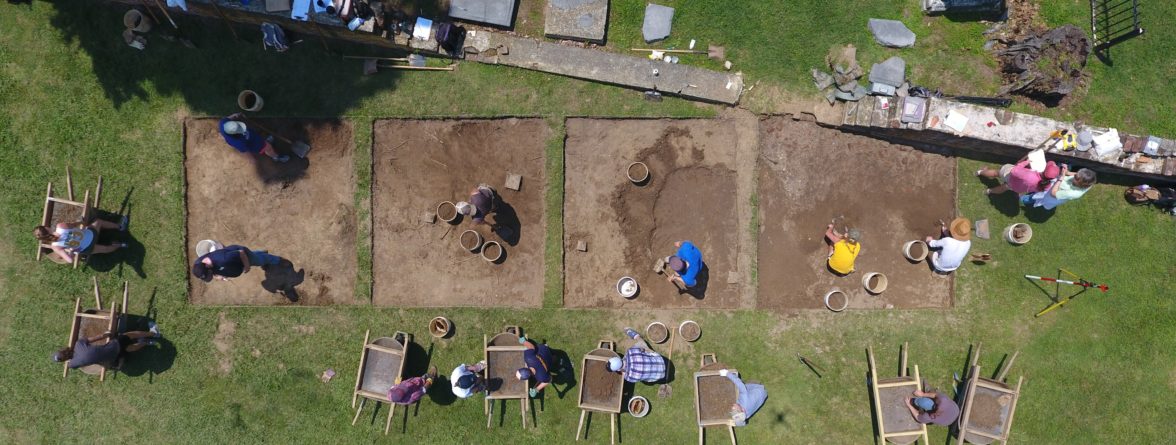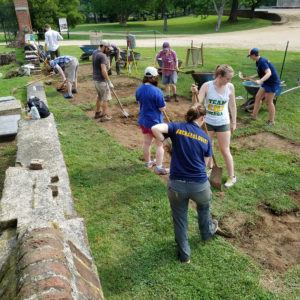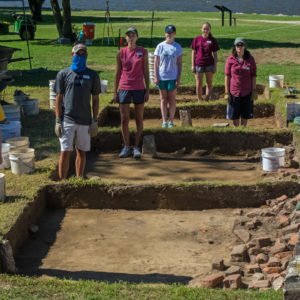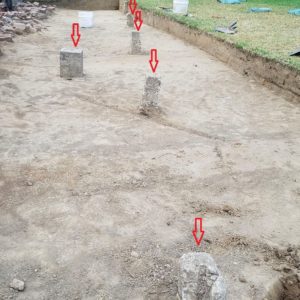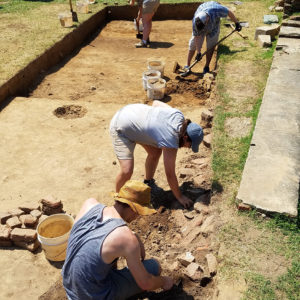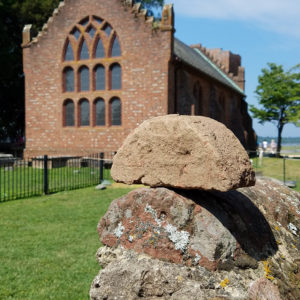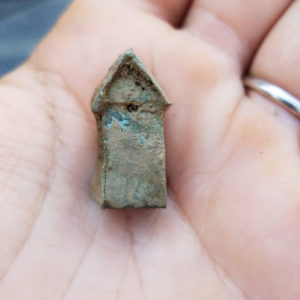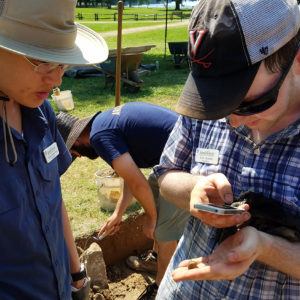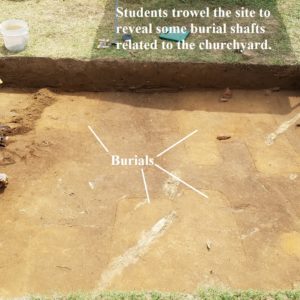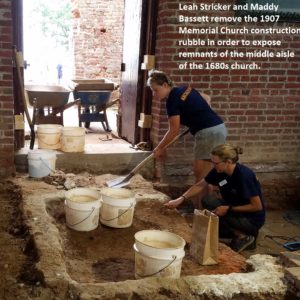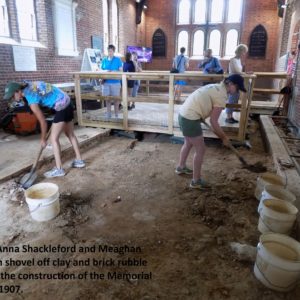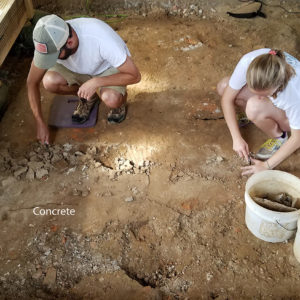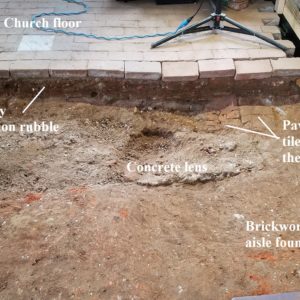Under the guidance of Jamestown Rediscovery archaeologists in June, students in the 2017 Archaeological Field School opened new test units east of the churchyard. Our goals were twofold: to uncover structures relating to the 1608 James Fort expansion, and to discover any evidence of the transition in 1624 from James Fort to Jamestown. In 2000, Rediscovery archaeologists excavated a nearby trash pit (Pit 5) that was filled in 1610 after the arrival of Lord Delaware, however, disturbances by later 17th-century graves erased any evidence of associated structures. It was hoped that associated structures or features would be revealed within the new units, located adjacent to and north of Pit 5.
On their first day in the field, students began by stringing out the units and removing sod. After the modern topsoil was removed, concrete supports were almost immediately exposed. These supports were for a black iron fence that once surrounded the churchyard. The fence was built in 1907 after the completion of the Memorial Church to protect the site when it was closed to the public. Shortly after the Jamestown Rediscovery Project started in the 1990’s, the fence was removed by the Association for the Preservation of Virginia Antiquities (APVA), and the concrete supports remained in situ.
Most of the overburden in the tests was landscaping fill dating to the late 19th century when the APVA acquired the property and started making improvements. Objects recovered from this layer included a wine glass fragment dated 1700 and various pieces of jewelry and buttons from the early 20th century.
Also encountered within the landscaping fill was a pile of bricks and brick rubble along the churchyard wall. The brick pile dates to the early 1900’s reconstruction of the brick churchyard wall. APVA preservationists at that time attempted to make the wall look like a Romantic ruin. As it and the surrounding soil were removed, a clear distinction between the original ca. 1800 wall and the above-ground 1900’s reconstruction became apparent. Discovered within the brick pile were several half-round coping bricks identical to those on the top of the reconstructed wall. The entire wall visible above ground today is reconstructed.
The last few inches of fill in every unit was comprised of intact colonial topsoil, which contained numerous early 17th-century artifacts. Students found lead sprue and waste from the lead shot manufacture. Several copper scrap fragments, two Nueva Cadiz beads, and two wrought iron fish hooks were also recovered. All are indicative of early 17th-century occupation at Jamestown.
Students also had the opportunity to excavate within the 1907 Memorial Church, and they helped staff archaeologists remove the overburden in the church’s west end that related to the 1907 construction of the building. Once the construction rubble was removed, a thin lens of excavation backfill from previous excavations was exposed. Students worked in pairs to remove this layer and reveal what the APVA’s preservationists saw over a hundred years ago!
A portion of the 1680’s middle aisle survived intact to the east, but in this new section staff and students found a thin layer of concrete was spread. After they removed the concrete, they found no sign of surviving brickwork. However, paver tiles were uncovered on the north side of the aisle—appearing just as they were when the church was abandoned in the 1750’s!
Although the in situ tiles are cracked, their placement is perfectly preserved. They are staggered like stretcher bond bricks. At present, it appears that the 2 foot wide brick aisle in the middle of the 1680s church was framed by tiles, at least on the north site. Only brick dust has been found on the south half of the aisle, thus the use of tiles in this section is difficult to prove.
Please stay tuned for more on the church excavations as we continue our search in July.
related images
- The 2017 Jamestown Field School opens four units just east of the churchyard to search for structures related to James Fort’s expansion and its transition into a town.
- Jamestown Rediscovery staff and field school open four new units just outside the churchyard wall hoping to uncover buildings related to Jams Fort’s 1608 expansion and related to the transition into a town afterwards.
- Field school students stand next to concrete piers that supported the 1907 iron fence that surrounded the Memorial Church and churchyard.
- Concrete supports for the iron fence that surrounded the churchyard from 1907 until the 1900’s.
- Fragment of a wine glass c. 1700 in landscaping fill located east of the churchyard wall.
- Churchyard wall excavations
- Removing the bricks in the pile. The bricks were likely related to the reconstruction of the churchyard wall in the late 19th or early 20th century.
- Among the bricks and rubble lying along the churchyard wall were several half-round coping bricks like those used by the APVA in the 1890’s reconstruction of the wall.
- Student Rebecca Leidenheimer removes the last few inches of overburden to reveal the historic features below.
- A small copper alloy windmill, likely a child’s toy, was found east of the churchyard wall.
- Students photograph the copper windmill toy found at the site.
- Students trowel the site to reveal some burial shafts related to the church
- Leah Stricker and Maddy Bassett remove the 1907 Memorial Church construction rubble in order to expose remnants of the middle aisle of the 1680’s church.
- Kaitlyn Fitzgeral shovels away backfill related to construction of the 1907 Memorial Church
- Students Anna Shackleford and Meaghan Harrington shovel off clay and brick rubble related to the construction of the Memorial Church in 1907.
- Field school student Nicole Grinbarg removes the 1907 Memorial Church construction rubble to expose a concrete lens poured over a depressed area of the church’s middle aisle.
- Adam Heck and Mary Catherine Talbott carefully remove a thin concrete lens placed over the church’s middle aisle by the early 20th-century excavators.
- Features under the Memorial Church floor


